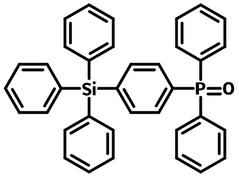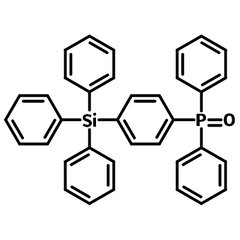TSPO1
CAS Number 1286708-86-8
Electron / Hole Transport Layer Materials, High Purity Sublimed Materials, Host Materials, Semiconducting Molecules, TADF Materials
TSPO1, fluorescent host or EBL material in TADF-OLED devices
Suitable for efficient electron injection and hole blocking
TSPO1, diphenyl[4-
TSPO1 from Ossila was used in the high-impact paper (IF 14.92), High efficiency blue organic light-emitting diodes with below-bandgap electroluminescence, M. Vasilopoulou et al., Nat. Commun., 12, 4868 (2021); DOI: 10.1038/s41467-021-25135-z.
With a sufficiently high triplet energy (ET ) of 3.36 eV, TSPO1 can be used as fluorescent host or exciton blocking layer materials in TADF-OLED devices. Also with low lying LUMO (ELUMO = 2.52 eV) and HOMO (EHOMO = 6.79 eV), TSPO1 is suitable for efficient electron injection and hole blocking, owing to the electron deficient nature of diphenylphosphine oxide moiety it bears.
General Information
| CAS number | 1286708-86-8 |
|---|---|
| Full name | Diphenyl[4- |
| Chemical formula | C36H29OPSi |
| Molecular weight | 536.67 g/mol |
| Absorption | λmax 266 nm in DCM |
| Photoluminescence | λmax 322 nm in DCM |
| HOMO/LUMO | HOMO = 6.79 eV, LUMO = 2.52 eV; ET = 3.36 eV [1] |
| Synonyms | Diphenylphosphine oxide-4-(triphenylsilyl)phenyl |
| Classification / Family | Triphenylsilyl derivatives, Bipolar host materials, Electron Injection layer (EIL) materials, Hole Blocking layer (HBL) materials, Fluorescent host materials, TADF materials, Organic printing electronics. |
Product Details
| Purity | Sublimed > 99% (HPLC) |
|---|---|
| Melting point | 236 °C (lit.) |
| Appearance | White crystals/powder |
Chemical Structure

Device Structure(s)
| Device structure | ITO/HATCN (7nm)/TAPC (40 nm)/DCDPA (10 nm)/CzCbPy: 20 wt% DMAC-DPS (25 nm)/TSPO1 (5 nm)/TPBi (30 nm)/LiF (1.5 nm)/Al (100 nm) [2] |
|---|---|
| Colour | Deep Blue |
| Max. Luminance | 8,035 cd/m2 |
| Max. Current Efficiency | 35.0 cd/A |
| Max. EQE | 22.9% |
| Device structure | ITO/HATCN (5 nm)/NPB (60 nm)/MCP (5 nm)/15 wt% PXZ-CMO:mCP (30 nm)/TSPO1 (5 nm)/TPBi (30 nm)/LiF (0.5 nm)/Al (150 nm) [3] |
|---|---|
| Colour | Green |
| Max. Luminance | 8,124 cd/m2 |
| Max. Current Efficiency | 38.2 cd/A |
| Max. EQE | 12.1% |
| Device structure | PEDOT:PSS (60 nm)/TAPC (20 nm)/mCP (10 nm)/DPEPO: TmCzTrz (25 nm)/TSPO1 (5 nm)/TPBI (20 nm)/LiF (1 nm)/Al (200 nm) [4] |
|---|---|
| Colour | Blue |
| Max. Power Efficiency | 52.1 Im/W |
| Max. EQE | 25.5% |
| Device structure | ITO (50 nm)/PEDOT:PSS (60 nm)/poly(9-vinylcarbazole) (15 nm)/SiCz:4CzIPN (30 nm)/TSPO1 (35 nm)/LiF (1 nm)/Al (200 nm) [5] |
|---|---|
| Colour | Green |
| Max. Power Efficiency | 63.4 Im/W |
| Max. EQE | 26% |
| Device structure | ITO/MoO3 (2 nm)/TAPC (40 nm)/TCTA (10 nm)/CzSi (3 nm)/CzSi:Pd-B-1* (10%):TTPA (1%) (20 nm)/TSPO1 (10 nm)/TmPyPb (40 nm)/LiF (1.2 nm)/Al (150 nm) [6] |
|---|---|
| Colour | Green |
| Max Current Efficiency | 38.85 cd/A |
| Max EQE | 10.41% |
| Max. Power Efficiency | 38.14 lm W-1 |
| Device structure | ITO (50 nm)/NPD (40 nm)/TCTA (15 nm)/mCP) (15 nm)/1 wt% DABNA-2*:mCBP(20 nm)/TSPO1 (40 nm)/LiF (1 nm)/Al (100 nm) [7] |
|---|---|
| Colour | Blue |
| Max. Current Efficiency | 21.1 cd/A |
| Max. EQE | 20.2% |
| Max. Power Efficiency | 15.1 lm W−1 |
| Device structure | ITO (50 nm)/NPD (40 nm)/TCTA (15 nm)/mCP) (15 nm)/1 wt% DABNA-2*:mCBP(20 nm)/TSPO1 (40 nm)/LiF (1 nm)/Al (100 nm) [8] |
|---|---|
| Colour | Yellow |
| Max. Current Efficiency | 66.2 cd/A |
| Max. EQE | 23.2% |
| Max. Power Efficiency | 56.2 lm W−1 |
| Device structure | ITO (120 nm)/PEDOT:PSS (60 nm)/TAPC (10 nm)/TCTA (10 nm)/mCP (10 nm)/DPEPO:DMAC-DPS:TBRb (25 nm)/TSPO1 (5 nm)/TPBI (30 nm)/LiF (1 nm)/Al (200 nm) [9] |
|---|---|
| Colour | White |
| Max Current Efficiency | 39.3 cd/A |
| Max EQE | 17.6% |
| Max. Power Efficiency | 41.0 lm W-1 |
*For chemical structure information, please refer to the cited references
Pricing
| Grade | Order Code | Quantity | Price |
|---|---|---|---|
| Sublimed (>99% purity) | M2199A1 | 100 mg | £260 |
| Sublimed (>99% purity) | M2199A1 | 250 mg | £520 |
| Sublimed (>99% purity) | M2199A1 | 500 mg | £900 |
| Sublimed (>99% purity) | M2199A1 | 1 g | £1500 |
MSDS Documentation
Literature and Reviews
- Arylsilanes and siloxanes as optoelectronic materials for organic light-emitting diodes (OLEDs), D. Sun et al., J. Mater. Chem. C, 3, 9496 (2015); DOI: 10.1039/c5tc01638j.
- δ-Carboline-based bipolar host materials for deep blue thermally activated delayed fluorescence OLEDs with high efficiency and low roll-off characteristic, J. Moon et al., RSC Adv., 8, 17025 (2018); DOI: 10.1039/c8ra01761a.
- Suppressing Efficiency Roll-Off of TADF Based OLEDs by Constructing Emitting Layer With Dual Delayed Fluorescence, Y. Zhang et al., Front. Chem., 7, 302 (2019); doi: 10.3389/fchem.2019.00302.

 TSPO1 MSDS sheet
TSPO1 MSDS sheet